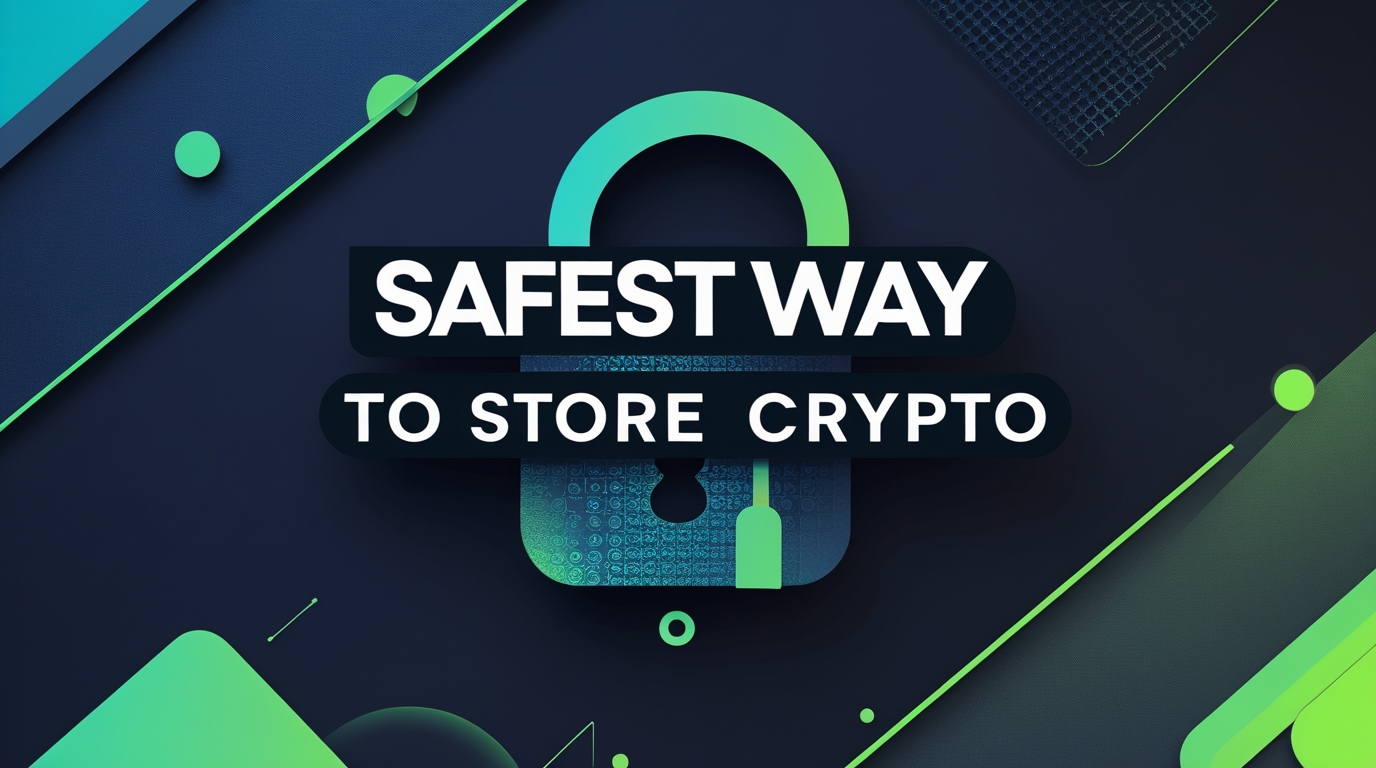
In the digital gold rush of today’s markets, questions of security loom large. Cryptocurrency unlocks a world of decentralized finance, but with it comes the responsibility of safeguarding one’s digital wealth. Unsecured crypto is like money hidden under a mattress – it may be out of sight, but it is not out of reach for thieves or accidents. Indeed, analysts report that crypto losses are mounting: Chainalysis found that over $2.2 billion was stolen in hacks and scams in 2024. Unlike traditional bank accounts, where a theft might be covered by insurance or recoverable, stolen cryptocurrency cannot be refunded or insured. As the U.S. FDIC bluntly states, crypto exchange deposits are not FDIC-insured. Faced with headlines of breaches and bankruptcies, newcomers often ask: “What is the safest way to store crypto?” The answer points squarely to self-custody solutions. By keeping private keys offline, investors shield their assets from the internet-based vulnerabilities of exchanges and hot wallets.
Overview: safest Way to Store Crypto
| Storage Method | Security Level | Internet Connection | Best Use Case | Key Advantages & Risks |
|---|---|---|---|---|
|
Hardware Wallets (Ledger, Trezor) |
HIGHEST | Offline (Cold Storage) | Long-term storage of significant holdings |
✓ Keys never touch internet
✓ Device confirmation required
✓ Malware resistant
⚠ Physical device can be lost
|
|
Paper Wallets (Physical key storage) |
HIGH | Offline (Cold Storage) | Long-term storage with multiple backups |
✓ Completely offline
✓ No device to break
⚠ Vulnerable to physical damage
⚠ Can be lost or destroyed
|
|
Software Wallets (Desktop/Mobile apps) |
MEDIUM | Online (Hot Storage) | Daily transactions and small amounts |
✓ Convenient access
✓ Quick transactions
⚠ Vulnerable to malware
⚠ Internet-connected risks
|
|
Exchange Storage (Coinbase, Binance, etc.) |
LOWEST | Online (Hot Storage) | Active trading only |
✓ Easy to trade
✓ User-friendly interface
⚠ Not FDIC insured
⚠ Exchange hack risk
⚠ You don’t control keys
|
• $2.2 billion stolen in crypto hacks and scams in 2024
• Exchange deposits are NOT FDIC-insured
• Golden Rule: “Not your keys, not your coins”
| Essential Security Practice | Implementation | Priority Level |
|---|---|---|
| Backup Seed Phrases | Store 12-24 word recovery phrases in multiple secure locations (fireproof safe, bank deposit box) | CRITICAL |
| Two-Factor Authentication | Use hardware security keys or authenticator apps (never SMS when possible) | CRITICAL |
| Unique Strong Passwords | Use password manager to generate unique passwords for each service | HIGH |
| Minimize Exchange Storage | Keep only trading amounts on exchanges; withdraw rest to personal wallets | CRITICAL |
What Is the Safest Way to Store Crypto? Hot vs. Cold Wallets
Cryptocurrency is controlled by cryptographic private keys – secret codes that grant access to funds. If someone else obtains those keys, they can drain the account. Thus, the core of secure crypto storage is keeping private keys in the safest possible environment. Broadly, storage options fall into two categories: hot wallets and cold wallets. Hot wallets (software wallets, mobile apps or exchange accounts) are convenient because they are connected to the internet, but that very connectivity makes them vulnerable to phishing, malware, and hacking. By contrast, cold wallets keep keys completely offline.
| Storage Type | Connectivity |
| Hot Wallet (software/mobile) | Internet-connected |
| Cold Wallet (hardware/paper) | Offline |
| Custodial (exchange) | Online |
As shown above, cold storage offers the most secure environment. By segregating keys from the internet, cold wallets make remote attacks nearly impossible. As Investopedia explains, moving keys into cold storage “prevents theft by hackers who might gain control of their hot wallets via viruses, malware, ransomware, or other methods”. This is why experts equate cold storage with owning one’s financial “savings account” in a vault rather than leaving it on a shelf.
On the other hand, hot wallets do have their uses. They allow quick access for trading or spending small amounts. A good practice is to keep only a modest amount of crypto in hot wallets (for day-to-day use) and transfer the bulk of one’s holdings to cold storage. Key security practices also include: strong, unique passwords and two-factor authentication (2FA) on every exchange or wallet; and never sharing private keys or seed phrases. For example, Coinbase’s Head of Security emphasizes using the strongest form of 2FA available (such as a hardware security key) to “dramatically improve [your] digital security”. In fact, one simple rule is often cited in crypto circles: if you do not hold your private keys offline, you do not truly own your crypto.
Hardware Wallets: The Safest Way to Store Crypto and Bitcoin
For most serious investors, hardware wallets are the gold standard of cold storage. These are physical devices (often USB-like) that generate and store private keys in a secure chip. They never expose the private key to an internet-connected device. Every transaction requires the user to confirm on the device itself, so malware on a computer cannot silently take coins. Notably, Kaspersky’s security experts point out that “one of the best ways to protect your crypto is to use a hardware wallet”, highlighting that seed words cannot be exported unencrypted and that offline operation makes malware infection extremely difficult. In short, hardware wallets act as an unhackable vault: even if a connected computer is compromised, the keys remain safe behind a PIN and isolated chip.
Popular hardware wallets such as Ledger or Trezor implement these protections. For example, Ledger’s devices store keys in an EAL6+ certified secure element; Trezor’s models use multi-layer defenses and open-source firmware. These products often support multiple cryptocurrencies on the same device. The EC-Council University cybersecurity team concurs that “if security is your top priority, a hardware wallet is your best bet”. In practice, this means generating your private keys on the hardware device and keeping the device itself under lock and key. If the device is lost or stolen, the funds are safe as long as the PIN is unknown and you have your recovery seed (the backup phrase).
Investors should also secure the backup of the seed phrase in physical form. Treat it like a safety deposit. For example:
- Store a copy of the 12- or 24-word seed phrase in a fireproof safe or locked drawer at home.
- Keep another copy in a bank’s safe-deposit box or a second secure location.
- Consider engraving or stamping the seed on stainless steel (to guard against fire or water damage).
This multi-location approach ensures that even if one backup is lost or destroyed, you can still recover your wallet. It may seem overly cautious, but the principle is simple: in crypto, self-reliance is the only insurance. One seasoned investor quips that keeping a crypto key is like carrying a piece of gold – if you lose it, nobody else can get it back. By comparison, storing your keys on an exchange is like storing your gold at someone else’s warehouse: convenient, perhaps, but ultimately someone else controls the padlocks.
Is Coinbase a Safe Place to Store Crypto?
Given Coinbase’s prominence, many beginners wonder “Is Coinbase a safe place to store crypto?” Coinbase is a well-regulated exchange and has extensive security measures. It holds large assets on behalf of customers and conducts regular audits. However, no centralized platform is impervious to risk. In May 2025, Coinbase experienced a cyberattack in which some customer personal information was leaked. While critical details like passwords, PINs, and private keys were not exposed in that incident, the breach was a stark reminder: attacks can happen anywhere.
After the breach, security experts emphatically advised users to move assets into cold storage. Business Insider summarized the advice: “To protect your cryptocurrency, use cold storage, be wary of scams, and never share your private keys”. In other words, even though Coinbase provides a secure trading platform, it is not intended as a permanent vault for large balances. Once crypto is on the exchange (hot storage), it remains subject to the twin threats of cyberattacks and internal failures. In fact, the U.S. FDIC explicitly warns that “crypto assets” held at exchanges are not FDIC-insured. This means that, unlike funds in a bank savings account, crypto on Coinbase has no government-backed guarantee.
For these reasons, experts generally recommend keeping only what you need for immediate trading on Coinbase or any exchange. Withdraw the rest to your own wallet. This could be a trusted software wallet or preferably a hardware wallet that you control. Think of exchanges as brokerages, not safes. Storing a lifetime of crypto earnings on an exchange is like buying gold bars and leaving them at the warehouse – it may be convenient for buying and selling, but it is not the safest place to store crypto.
Safest Way to Buy and Store Crypto: Best Practices
Acquiring and securing crypto go hand in hand. When buying crypto, start by choosing a reputable, regulated platform. Check that the exchange follows Know-Your-Customer (KYC) laws and holds licenses. After purchase, a good habit is to transfer funds directly to your personal wallet rather than letting them idle on the exchange. For example, some decentralized exchanges (DEXs) allow buying directly into a self-custody wallet. If you must use a custodial exchange, withdraw to a wallet you control as soon as possible.
Once bought, always treat your crypto storage like digital security planning:
- Store long-term assets offline. Keep significant holdings in a hardware wallet (or even a secure paper wallet stored in multiple places). This “most secure way to store crypto” means the keys never touch the internet. As Kaspersky explains, a hardware wallet’s offline design makes it “extremely difficult for an attacker to infect it with malware”. In practice, implementing offline storage is the single largest step toward full security.
- Enable every available security feature. At every service (exchanges, mobile wallets), use the strongest available two-factor authentication. As Coinbase’s security team puts it, even SMS-based 2FA is much better than none; but a hardware security key (like YubiKey) or authenticator app is ideal. Also use a password manager to generate and store unique passwords for each account.
- Never share your private keys or recovery phrase. Treat them like the PIN to your life savings. No legitimate service will ask you to reveal these secrets. Keep them offline – writing them in a locked notebook or on non-digital media is common advice.
- Keep software updated and watch for phishing. Even with a hardware wallet, be careful: use only official wallet apps and websites. Always verify URLs and be skeptical of unsolicited messages asking for credentials.
Finally, remember that global regulators are increasingly focused on secure custody. While today’s guidance often comes from security experts, formal rules are emerging. For example, the Financial Action Task Force (FATF) standards and new regulations in the EU and U.S. demand rigorous custody protocols for crypto firms. These rules effectively endorse cold and multi-party storage as best practice. In short: do not wait for a breach to act. The safest way to buy and store crypto is to assume you must protect your keys yourself from Day One.
“One of the best ways to protect your crypto is to use a hardware wallet,” Kaspersky cybersecurity experts advise, noting that these devices keep seed words encrypted and offline. Echoing that view, EC-Council University’s cybersecurity guide concurs that “if security is your top priority, a hardware wallet is your best bet”. Even major exchanges emphasize personal security: Coinbase’s security lead reminds users that “with just a few easy steps” one can greatly improve account safety. In practice, that means moving as much crypto as possible into your own hands – ideally in a cold wallet – where only you hold the keys.In conclusion, storing cryptocurrency safely is about combining technology and discipline. The most secure way to store crypto is to keep private keys off the internet, behind hardware-enforced walls, and backed up in the real world. By treating crypto like digital gold and locking it in a personal vault, investors can sleep better at night. After all, as one crypto security motto goes: not your keys, not your coins. The safest place for your crypto is under your own lock and key – not in someone else’s.
FAQs
1. What is the absolute safest way to store cryptocurrency long-term?
The safest method is using a hardware wallet for cold storage. Hardware wallets like Ledger and Trezor store your private keys offline in a secure chip, making remote hacking nearly impossible. Your keys never touch the internet, and every transaction requires physical confirmation on the device itself.
Critical backup strategy: Store your 12-24 word recovery phrase in multiple secure locations – one in a fireproof safe at home, another in a bank safety deposit box, and consider engraving it on stainless steel for maximum durability against fire or water damage.
2. Is it safe to leave my crypto on exchanges like Coinbase?
No, exchanges should not be used for long-term storage. While Coinbase is well-regulated and has security measures, it’s still a hot wallet connected to the internet. Exchange deposits are not FDIC-insured, and even Coinbase experienced a cyberattack in May 2025 where customer information was leaked.
Remember: Over $2.2 billion was stolen in crypto hacks and scams in 2024 alone. Unlike traditional banks, stolen cryptocurrency cannot be refunded or insured. Keep only small amounts needed for active trading on exchanges, and withdraw the rest to your personal wallet immediately.
3. What’s the difference between hot wallets and cold wallets?
Hot wallets are connected to the internet (software wallets, mobile apps, exchanges) making them convenient but vulnerable to hacking, malware, and phishing attacks.
Cold wallets store your private keys completely offline (hardware wallets, paper wallets), making remote attacks nearly impossible.
Think of hot wallets as your checking account for daily use, and cold wallets as your savings account vault. Use hot wallets for small amounts you need for daily transactions, but store the majority of your holdings in cold storage.
4. What happens if I lose my hardware wallet or forget my recovery phrase?
If you lose your hardware wallet but have your recovery phrase, you can restore your funds on a new device – the physical wallet is just the interface, not the actual storage.
However, if you lose your recovery phrase, your crypto is gone forever. No one can recover it – not the wallet manufacturer, not exchanges, not even law enforcement.
Critical rule: Your recovery phrase IS your cryptocurrency. Treat it like the deed to your house – store multiple copies in different secure locations and never share it with anyone.
5. What security features should I enable to protect my crypto accounts?
Enable these security features on all your crypto-related accounts:
- Two-Factor Authentication (2FA) – Use hardware security keys (like YubiKey) or authenticator apps, never SMS when possible
- Unique, strong passwords – Use a password manager to generate different passwords for each service
- Email notifications – Get alerts for all login attempts and transactions
- Withdrawal whitelists – Only allow withdrawals to pre-approved addresses
- Regular software updates – Keep all wallet apps and security software current
Golden rule: “Not your keys, not your coins.” The safest crypto is the crypto you control completely through self-custody solutions.
Our Review Methodology
We evaluate each post based on thorough research, credibility of sources, accuracy of information, and relevance to our readers. Our editorial team follows strict guidelines to ensure all content meets high standards of quality.
Disclaimer
The content in this article is provided for informational purposes only and does not constitute financial, investment, or professional advice. Always do your own research before making any decisions.


